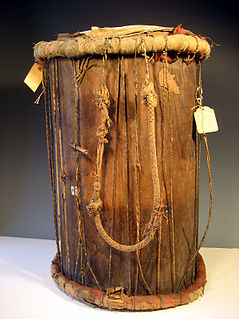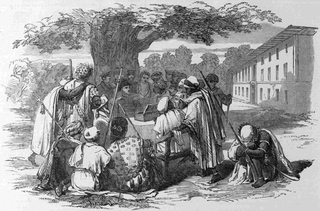 W
WThe medieval history of the Serer people of Senegambia is partly characterised by resisting Islamization from perhaps the 11th century during the Almoravid movement, to the 19th century Marabout movement of Senegambia and continuation of the old Serer paternal dynasties.
 W
WThe prehistoric and ancient history of the Serer people of modern-day Senegambia has been extensively studied and documented over the years. Much of it comes from archaeological discoveries and Serer tradition rooted in the Serer religion.
 W
WThe Adrar is a highland natural and historical region of the Sahara Desert in northern Mauritania. The Adrar Region, an administrative division of Mauritania, is named after the traditional region. It is sometimes called Adrar Tamar to distinguish it from other areas called Adrar in the Sahara.
 W
WThe Battle of Fandane-Thiouthioune, also known as the Battle of Somb or the Battle of Somb-Tioutioune, occurred on 18 July 1867. It was a religious war between the Serer people and the Muslim Marabouts of the 19th century in Senegal and The Gambia, but it also had a political and economic dimension to it: vendetta and empire-building. Fandane, Thiouthioune and Somb were part of the pre-colonial Serer Kingdom of Sine now part of independent Senegal.
 W
WBuumi was a Serer royal title in the Serer pre-colonial Kingdoms of Sine, Saloum and previously Baol. All these pre-colonial Serer kingdoms are now part of modern-day Senegal. However, present-day Gambia, was called Lower Saloum and a former colony of the Kingdom of Saloum. The Buumi always a member of the royal family. He was the first in line to inherit the throne of the Maad a Sinig or Maad Saloum. In some cases, a Buumi can act as regent if the king is too young, as was the case with Maad a Sinig Ama Joof Gnilane Faye Joof, whose uncle was appointed regent until Maad Ama Joof became much older. In pre-colonial Sine, the Buumi usually took residence at Somb Rongodior. In many cases, he was elected by the Maad a Sinig as his successor, however, the Great Jaraff and his Noble Council of Electors generally decides which member of the royal family succeeds to the throne. When Maad a Sinig dies without nominating his Buumi, as was the case with Maad a Sinig Mbackeh Ndeb Njie, the "thilas" may succeed him as was the case with Maad a Sinig Kumba Ndoffene Fa Ndeb Joof.
 W
WThe Battle of Logandème was an uprising led by the Serer King Maad a Sinig Kumba Ndoffene Famak Joof, king of Sine, against the French Empire. The battle took place at Logandème which was a part of Sine at the time. The battle was also a revenge attack against the Serer people after their resounding victory against France at the Battle of Djilass on 13th May 1859. It was the first time that France decided to employ cannonball in the Senegambia.
 W
WThe title Loul is an ancient royal title used in the pre-colonial Serer kingdoms, such as the Kingdom of Sine, the Kingdom of Saloum and formerly the Kingdom of Baol. These three pre-colonial kingdoms are now part of independent Senegal. The Loul was the third in line to the throne after the Buumi and Thilas. In old Serer language, Loul means "envoyer".
 W
WMaad a Sinig means king of Sine. The ancient Kingdom of Sine, now part of Senegal, was a pre-colonial Serer kingdom. Their kings were titled Maad or Maad. The royal title Maad is sometimes used interchangeably with their ancient kings and landowners - the Lamanes. Between 1350 and 1969, more than fifty Serer kings have been crowned Maad a Sinig.
 W
WMaad Saloum means king of Saloum, in the Serer language. The ancient Kingdom of Saloum now part of present-day Senegal was a pre-colonial Serer kingdom. Their kings bore the title Maad or Mad. The royal title was sometimes used interchangeably with that of their ancient kings and landed gentry - the lamanes.
 W
WThe Senegambian stone circles lie in The Gambia north of Janjanbureh and in central Senegal.
 W
WThe Soninke-Marabout War of 1850 to 1856 was a civil war between factions of the Kingdom of Kombo in the Gambia. The war resulted from a dispute between the Soninke people – pagans who were the ruling class in Kombo – and the Marabouts – a radical Muslim group with no representation in the governance of Kombo, partially inspired by Jihad. The British Empire, to whom parts of Kombo had been ceded by the Soninke since 1816, was initially reluctant to intervene. However, during the course of the war, the British intervened on two occasions. British forces stormed the Marabout town of Sabbajee twice, in 1853, and again in 1855, raising the town following the second intervention.
 W
WTakrur, Tekrur or Tekrour was an ancient state of West Africa, which flourished roughly parallel to the Ghana Empire.
 W
WThe talking drum is an hourglass-shaped drum from West Africa, whose pitch can be regulated to mimic the tone and prosody of human speech. It has two drumheads connected by leather tension cords, which allow the player to change the pitch of the drum by squeezing the cords between their arm and body.
 W
WTeigne was the title of the monarch of the pre-colonial Kingdom of Baol, now part of present-day Senegal.
 W
WThilas was an ancient title of nobility used in the Serer pre-colonial Kingdoms of Sine, Saloum and previously the Kingdom of Baol, which are all now part of modern-day Senegal. The Thilas was the second in the order of succession to the throne after the Buumi who was the heir apparent. Only members of the royal family could hold this title. When a Maad a Sinig dies without a Buumi, the Thilas could ascend the throne at the discretion of the Great Jaraff and his Noble Council of Electors responsible for electing the kings from the royal family. In the history of Sine to its 20th century history, such an incident is only known to have occurred once, at the succession of Maad a Sinig Kumba Ndoffene Fa Ndeb Joof whose predecessor died without a Buumi.